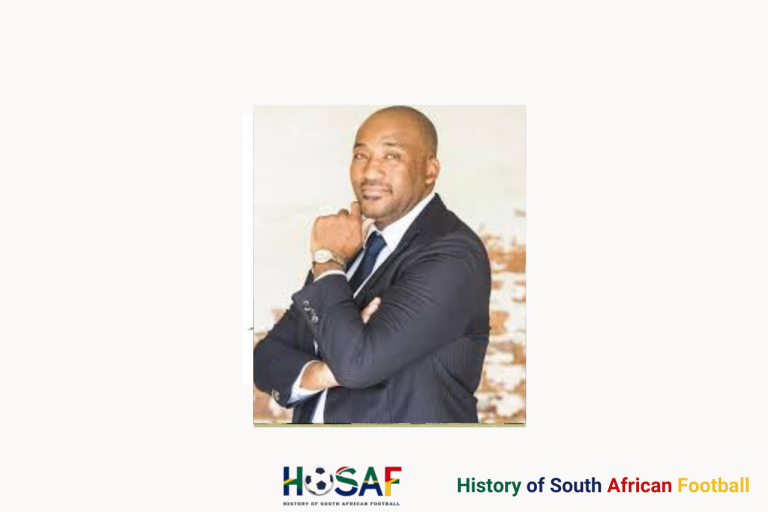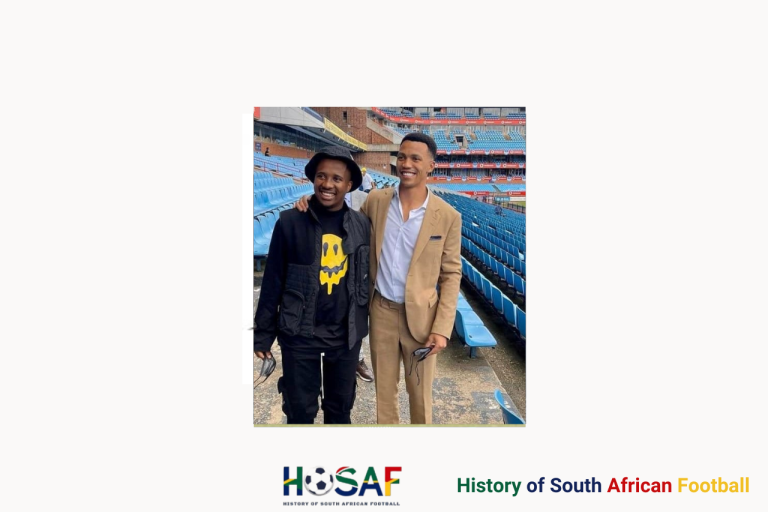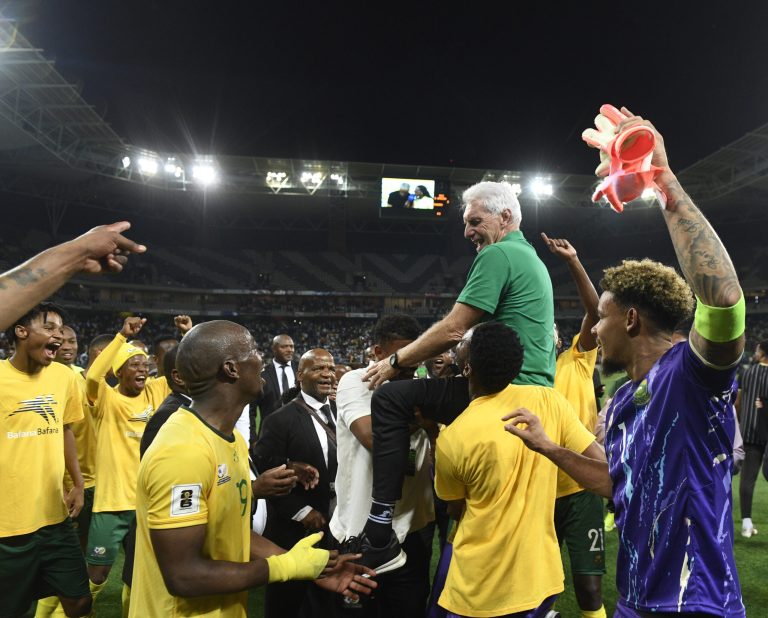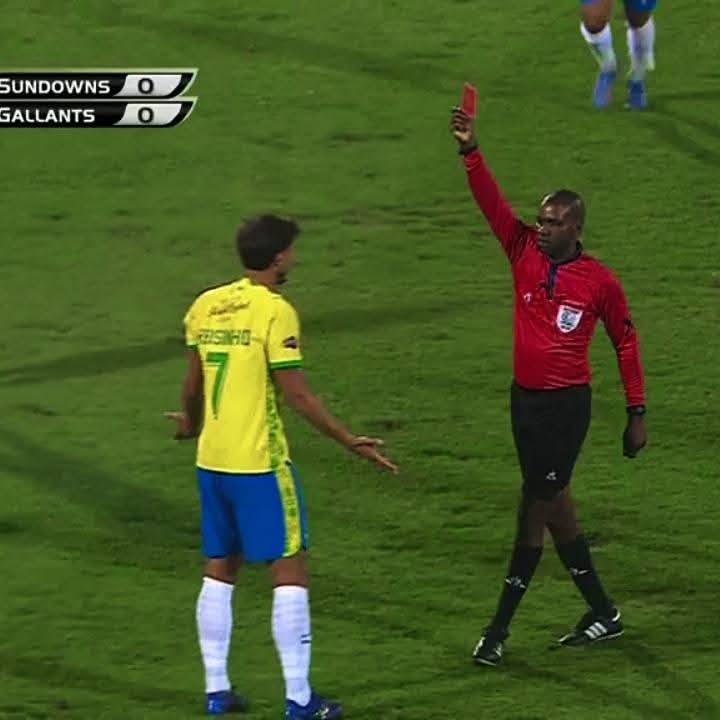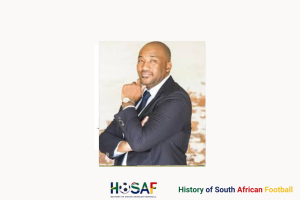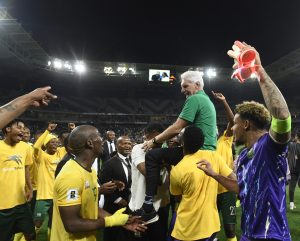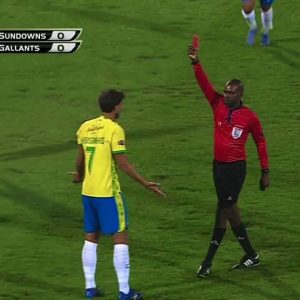1. Name:
Moroka Swallows Football Club
2. Founding Date:
1947
3. Owner/Chairman:
David Mogashoa
4. Nicknames:
The Birds, Dube Birds, Beautiful Birds
5. Slogan/Motto:
“I Believe”
6. Home Ground:
Dobsonville Stadium, Soweto, Johannesburg
(Capacity: ~24,000)
7. Achievements – Trophies & Titles (11 Major Honours)
⚽ League Titles (1):
- National Professional Soccer League (NPSL): 1965
🏆 Domestic Cups (10):
- Nedbank Cup / FA Cup: 5
(1983, 1984, 1989, 2004, 2009) - MTN 8 / Top 8 / BP Top 8: 3
(1975, 1979, 2009) - NSL Challenge Cup: 1
(1988) - Telkom Knockout / League Cup: 1
(2012)
🥈 Notable Runners-Up:
- PSL Runners-Up: 1994–95, 2011–12
- CAF Competition Appearances: Multiple, including CAF Cup Winners’ Cup
8. Sponsors:
- Past & Present Sponsors Include:
- Volkswagen (VW) – Principal sponsor (2000s–2010s)
- Engen Petroleum
- Elephant Lager
- Vodacom
- ABSA / Nedbank / Telkom (via league and cup affiliations)
- Kit Manufacturers:
- Umbro, Lotto, Le Coq Sportif (historically)
- Drip (Recently)
9. Reputable Players:
- Andries “Chaka Chaka” Mpondo
- Joel “Ace” Mnini
- Aaron “Roadblock” Makhathini
- Maimane Phiri
- Lefa Tsutsulupa
🕊️ Key Leadership Eras in Moroka Swallows’ History
Here’s a simplified bullet-point list of notable leadership figures and eras:
- 1947–1960s:
- Founding Leadership – Strike Makgatho, Ishmael Lesolang, Jeremiah Gumede
- Community-run with personal financial backing
- 1970s–Early 1980s:
- Internal player-coach transitions
- No formal board-level leadership; run by founding members and player elders
- 1980s (Golden Era):
- Jack “Big Daddy” Sello – Chairman
- David “Pine” Chabeli, Boy “Baard” Nhlapho, Sylvester Masinga, Abe Machele – Administrators
- Known for stability and cup success
- Mid-1980s (NSL/NPSL Split Era):
- Factional division – Roadblock Makhathini assassination
- Leadership crisis during league realignment
- 1990s:
- David Chabeli – Club Chairman
- Continued until late ’90s under heavy financial strain
- 1999–2015:
- Leon Prins (CEO & Major Shareholder via FB Investments)
- Oversaw PSL return and cup success in early 2000s
- 2018–2024:
- David Mogashoa (Owner & Chairman)
- Partnered with Panyaza Lesufi
- Eventually sold to Marumo Gallants in 2024
I. Origins and Formation (1947–1957)
In 1947, amidst the dusty alleys of Moroka Jabavu in Soweto, a spark was lit that would grow into one of South Africa’s most iconic football flames. That year, a few football-loving young men, guided by community leaders and business men, Strike Makgatho, Ishmael Lesolang, Joseph Manana, and Jeremiah Gumede, formed a team that would not just survive—they would soar.
The club’s original name was Moroka Sweepers, but one of the early players, Difference Mbanya, felt the name lacked soul. “Sweepers clean things up,” he argued, “but a **swallow never dies—it just disappears in winter and returns in summer. A swallow soars.” The idea caught on, and Moroka Swallows was born. A name that would echo for generations.
At that time, football was not about professional contracts or sponsorships. It was about community, passion, and resilience. The players had no boots, walking barefoot to games, often catching rides on the backs of bakkies. They played matches in alleyways, parks, or wherever they could find an opponent, often standing in for no-show teams in local leagues. Their first ball was borrowed. Their kits were hand-stitched. But what they had was soul, and it was powerful.
By 1953, Swallows—now affectionately known as The Birds—had become a force, winning the Johannesburg African Football Association (JAFA) League, followed by back-to-back Robinson Cups in 1954 and 1955. In 1956, they stunned giants Orlando Pirates, winning the Transvaal Challenge Cup in a 6-5 thriller. They had arrived.
Their games became township blockbusters. Crowds grew. So did the legend of players like Carlton Moloi, Shakes Moloi, Essau “Inch by Inch” Madi, Difference and Lawrence Mbanya, and Abraham “Al Die Hoekies” Meyers, an acrobatic goalkeeper who amazed fans with his circus-like saves. These were not just footballers—they were township celebrities, symbols of black excellence in an apartheid era that tried to deny it.
II. Going Professional and the First Crisis (1957–1967)
By the late 1950s, Swallows had established themselves as South Africa’s most stylish and feared side, alongside Orlando Pirates. In 1957, they won the Wemmer Cup, and by the end of the decade, they were a full-fledged powerhouse.
In 1959, the team recorded a legendary 7–4 victory in the Robinson Cup final, with Carlton Moloi scoring four goals and assisting three. His heroics earned him a move to Cardiff City in England, where he joined fellow South African, Steve “Kalamazoo” Mokone—a groundbreaking moment for South African football.
In 1961, Moroka Swallows officially turned professional, joining the South African Soccer League (SASL). They were now part of a newly emerging era in South African football—a time when teams were formalizing player wages and match revenues, bringing structure to what had been a chaotic but thrilling sport.
But the 1960s were also marked by conflict and division. A national battle was brewing between the SASL and the breakaway National Professional Soccer League (NPSL), and Swallows found themselves torn. Internally, a deep rift opened in 1964 between players loyal to Difference Mbanya and those siding with the returning Carlton Moloi, who had come back from England.
The issue: whether to remain in the SASL or move to the NPSL. This led to a full-blown split within the club, with Mbanya’s group forming “Swallows Babes” and Moloi’s group continuing as “Swallows Big XV.” Even founding member Strike Makgatho left the club, later helping Kaizer Motaung establish Kaizer Chiefs.
This was nearly the end of Moroka Swallows. But the club held together—fractured but alive.
III. The Age of the Massacres and Rising Again (1968–1984)
After years of internal war, Swallows began to heal. The late 1960s and 1970s saw the Birds regain their flight.
In 1979, under the leadership of Jack “Big Daddy” Sello, Swallows claimed the BP Top 8 after a dramatic 4-2 aggregate win over Pirates. Sello, a master administrator, ran the club with a sharp mind and a big heart—always making sure players were paid, even when there was no money.
The 1980s marked the era of the “Massacres”—a nickname given to Swallows players whose surnames mostly started with the letter “M.” This iconic lineup included Andries “Six Mabone” Maseko, Trott Moloto, Frederick “Congo” Malebane, Shakes Mashaba, and Joel “Ace” Mnini. The Birds were feared, stylish, and dominant.
They reached the 1980 Mainstay Cup final, the 1982 BP Cup final, and won the 1983 Mainstay Cup with a last-minute goal from Mnini. They had rediscovered their wings.
IV. The 1985 Breakaway and the Tragedy of Roadblock (1985–1988)
But just as they were soaring again, 1985 delivered one of the darkest moments in South African football.
That year, South African football underwent massive upheaval. Many clubs, led by Kaizer Motaung, broke away from the NPSL to form the National Soccer League (NSL)—a move Swallows was hesitant to support. Amid this uncertainty, four key Swallows players—Congo Malebane, Aubrey Makgopela, Joel Mnini, and Aaron “Roadblock” Makhathini—left to form a new team called The Mighty Birds, affiliated to the old NPSL.
Rumors swirled that their lives were in danger. Then, on April 12, 1985, tragedy struck. Aaron Makhathini was gunned down in front of his home after a training session. Two Swallows officials were arrested but later released. The murder shook the football community to its core and remains one of the sport’s darkest chapters.
Yet, even in grief, Swallows rebuilt. Coach Mario “The Godfather” Tuani assembled a young, hungry team: Andries Mpondo, Bennett Lushozi, Master Motloung, Walter Mabeba, and others. They played with heart and hunger. In 1986, under Rodney Bush, Swallows reached the JPS Cup final against Chiefs, narrowly losing on aggregate but winning the respect of fans across the country.
V. The Hunt for Glory and Rebuilding (1989–1999)
In 1989, Swallows hired former Manchester United player Eddie Lewis as head coach. Known for his discipline and tactical mastery, Lewis brought professionalism back. That year, Swallows stunned Sundowns with a 5-1 win in the Bob Save Super Bowl final, after a 1-1 draw in the first leg.
The 1993 season was particularly bittersweet. Coached by Mich d’Avray, Swallows came within a point of winning the league. But they faltered in the last game, and Sundowns edged them out for the title. That team—featuring Roger de Sa, Joseph Leepo, Eric Ramasike, Goodman Hlongwane, and Andries Mpondo—was seen as Swallows’ finest of the era.
But the success didn’t last. The Birds spiraled. In the newly formed PSL (1996), they finished 11th, then 15th. Fans left the stands. The maroon and white shirt, once worn with pride, became a reminder of what was lost.
VI. Modernization and the Gavin Hunt Era (1999–2007)
Change came in 1999, when businessman Leon Prins took over half the club from David Chabeli. Financial stability followed. So did a new vision.
Enter Gavin Hunt, a young, promising coach. Under his leadership:
- Swallows finished 4th in 2002/03, then won the ABSA Cup in 2004
- Continued with top 5 finishes through 2006
- Finished 3rd in 2006/07, their best PSL result in the modern era
Hunt left in 2007, but Swallows had rediscovered their flight. The Birds were relevant again.
VII. Recent Years, Fall, and Rebirth (2008–Present)
After Hunt, coaches came and went—Julio Leal, Zeca Marques, Ian Gorowa—each bringing change but not lasting success.
In 2009, Swallows lifted the Nedbank Cup, but by 2014, the club was in free fall. Relegation followed in 2015. At one point, Swallows had dropped to the third tier (ABC Motsepe League). For a club of their legacy, it was heartbreaking.
But the swallow, as Mbanya once said, never dies—it disappears and comes back.
In 2020, Swallows FC returned to the top flight, reclaiming their spot in the Premier Soccer League. Back in maroon and white. Back in Dobsonville. Back in the hearts of supporters who had never stopped chanting: “I believe!”
Legacy: I Believe
Moroka Swallows is not just a football club. It is:
- The first black-owned professional team in South African history
- A pioneer of flair, identity, and resistance in the face of apartheid
- A club whose players walked to games barefoot and went on to inspire a nation
Through every division, murder, relegation, and return, Swallows remained the heartbeat of Soweto football. Their legacy is carved in sweat, tragedy, and triumph. They were the first, they have fallen, and they have risen again.



